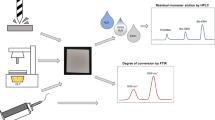Abstract
Dental composites are widely used by dentists as restorative material to restore tooth fractures and dental caries or decay. Dental composites often contain advanced nanomaterials. After restoring a tooth, the dentist may use a high-speed handpiece to contour the surface of the composite through the process of drilling, utilizing various dental burs depending on the situation. Additionally, dentists must often remove existing composite restorations for numerous reasons (e.g., recurrent decay or need for a crown). If appropriate controls, such as water aerosol in conjunction with the grinding process and/or local exhaust ventilation, are inadequately utilized, both the dentist and patient may inhale airborne particles released in the drilling process. This study aimed to identify the potential exposure from dental procedures that utilize advanced nanocomposites and to characterize the particles released from commonly used dental composites. To identify the characteristics and elemental composition of the released particles, a uniquely designed nanoparticle sampler, a Sioutas cascade impactor, and real-time instruments were utilized. Both microscopic and size-fractionated concentration analyses confirmed the release of nanometer-sized particles consisting of various metal components that are potentially concerning for human exposure. These results elucidate the potential nanoparticle exposure that may occur during dental practice with advanced materials, based on simulated restoration grinding situations.









Similar content being viewed by others
References
Asbach C, Kaminski H, Fissan H, Monz C, Dahmann D, Mulhopt S, Paur HR, Kiesling HJ, Herrmann F, Voetz M, Kuhlbusch TAJ (2009) Comparison of four mobility particle sizers with different time resolution for stationary exposure measurements. J Nanopart Res 11:1593–1609. https://doi.org/10.1007/s11051-009-9679-x
ATSDR (2007) Barium, public health statement, CAS#: 7440-39-3. Agency for Toxic Substances and Disease Registry (ATSDR) August
Besinis A, De Peralta T, Tredwin CJ, Handy RD (2015) Review of nanomaterials in dentistry: interactions with the oral microenvironment, clinical applications, hazards, and benefits. ACS Nano 9:2255–2289
Brouwer DH, Gijsbers JHJ, Lurvink MWM (2004) Personal exposure to ultrafine particles in the workplace: exploring sampling techniques and strategies. Ann Occup Hyg 48:439–453
Hannig M, Hannig C (2010) Nanomaterials in preventive dentistry. Nat Nanotechnol 5:565–569
Ivoclar Vivadent (2011) Tetric EvoCeram: direct composite technology has evolved
Khattak J, Theisen D, Tsai CSJ (2019) The sampling technique on collecting fine carbon nanotubes fibers for exposure assessment: a case study. Sci Rep J 9:7137
Lang A, Ovsenik M, Verdenik I, Remškar M, Oblak Č (2018) Nanoparticle concentrations and composition in a dental office and dental laboratory: a pilot study on the influence of working procedures. J Occup Environ Hyg 15:441–447
NIOSH (1994) Asbestos by TEM, Department of Health and Human Services, Centers for Disease Control and Prevention, National Institute for Occupational Safety and Health, Cincinnati, OH
NIOSH (2019) Barium chloride (as Ba). The National Institute for Occupational Safety and Health (NIOSH). https://www.cdc.gov/niosh/npg/npgd0045.html. Accessed 2019
OSHA (2012) Occupational safety and health standards, toxic and hazardous substances, hazard communication. Occupational Safety and Health Administration (OSHA) Standard 29 CFR 1910.1200
Schmalz G, Hickel R, van Landuyt KL, Reichl F-X (2018) Scientific update on nanoparticles in dentistry. Int Dent J 68:299–305
Scientific T (2010) Mounting medium, material safety data sheet. Richard Allan Scientific, Kalamazoo
Scientific T (2018) Ytterbium safety data sheet. Fisher Scientific, Fair Lawn
Stones F, Robinson E, Johansen D, Albrecht BJ (2016) Crystalline silica quartz and cristobalite. Methods Development Team Industrial Hygiene Chemistry Division OSHA Salt Lake Technical Center
Tsai CS, Theisen D (2018) A sampler designed for nanoparticles and respirable particles with direct analysis feature. J Nanopart Res 20:209. https://doi.org/10.1007/s11051-018-4307-2
Van Landuyt KL, Yoshihara K, Geebelen B, Peumans M, Godderis L, Hoet P, Van Meerbeek B (2012) Should we be concerned about composite (nano-)dust? Dent Mater 28:1162–1170
Van Landuyt KL, Hellack B, Van Meerbeek B, Peumans M, Hoet P, Wiemann M, Kuhlbusch TAJ, Asbach C (2014) Nanoparticle release from dental composites. Acta Biomater 10:365–374
Funding
This project was supported by start-up funds from Colorado State University.
Author information
Authors and Affiliations
Corresponding author
Ethics declarations
Conflict of interest
The authors declare that they have no conflict of interest.
Additional information
Publisher’s note
Springer Nature remains neutral with regard to jurisdictional claims in published maps and institutional affiliations.
Rights and permissions
About this article
Cite this article
Shin, N., Drapcho, J., Aich, N. et al. Quantification and characterization of nanometer-sized particles released from dental composite products using a multimodal approach. J Nanopart Res 22, 345 (2020). https://doi.org/10.1007/s11051-020-05078-0
Received:
Accepted:
Published:
DOI: https://doi.org/10.1007/s11051-020-05078-0




